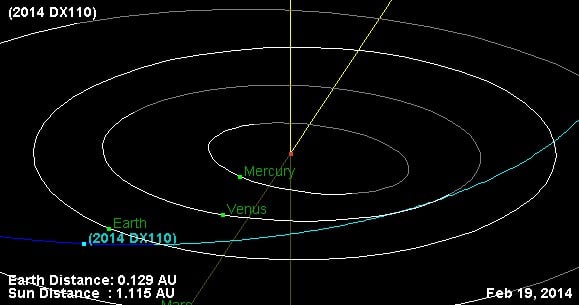BREAKING- No sooner than the cyber-ink was dry on this post than we got notice of
another
10-metre NEO asteroid 2014 EC passing Earth at just under 0.2 times the Earth-Moon distance - less than 64,000 kilometres - on Thursday, March 6th at 21:18 UT/4:18 PM EST. And the
Virtual Telescope
will be carrying this passage live as well on March 6th starting at 19:00 UT/2:00 PM EST. Bring in on, universe!
The Earth-Moon system gets a close shave on the night of Wednesday, March 5
th
2014 when Near Earth Object (NEO) asteroid
2014 DX110
passes our fair planet at 216,000 miles or about 345,600 distant at around 21:06 Universal Time (UT)/ 4:06 PM EST.
About 30 metres in diameter, 2014 DX110 was discovered by the Pan-STARRS 1 survey on February 28
th
, and its
orbit
was initially refined using follow up observations made by the
Great Shefford Observatory
in West Berkshire, England.
And although the asteroid is no threat to Earth or the Moon – it makes a pass 232,800 miles from our natural satellite one hour and 22 minutes after its closest passage from the Earth – the asteroid is currently listed on
NASA's risk page
for a 1 in 10,000,000 chance of impact with Earth on March 4
th
, 2046.
Of course, additional observations usually lower this remote possibility even further in the case of most newly discovered near Earth asteroids. Visually, 2014 DX110 isn't expected to brighten above +15
th
magnitude as it glides northward through the constellation of Camelopardalis at closest approach Wednesday night.
But the good news is, you can catch the passage of 2014 through the Earth-Moon system Wednesday night courtesy of our friends at the
Virtual Telescope Project
:
The webcast of the event is expected to go live at 20:30 UT, and will include live commentary.
Its been a busy last few weeks in terms of asteroid flybys, including a passage of Amor NEO asteroid 2014 DU110 earlier today at 15:54 UT/10:54 AM EST at 0.14 A.U.s or just over 20 million kilometres distant. And the folks at the Virtual Telescope Project will be covering another asteroid flyby on Sunday, March 9
th
starting at 23:00 UT/6:00 PM EST to track the 180 meter asteroid 2014 CU13. This large Apollo NEO is projected to pass 8 lunar distances or over 3 million kilometres away from the Earth on March 11
th
at 9:05 UT/4:05 AM EST.
It should be easy to pick out the motion of 2014 DX110 moving against the starry background at closest approach in real time. 2014 DX110 is an Apollo-class asteroid, and has an orbital period of 1192 days or about 3.26 years. It also has a fairly shallow inclined orbit relative to the ecliptic traced out by Earth's path around the Sun, with a tilt of just over 5.7 degrees. This means that 2014 DX110 is approaching the Earth from just southward and behind it in its orbit around the Sun before crossing just inside of our orbit and northward of the ecliptic plane.
The discovery of asteroid 2014 DX110 was announced by the Minor Planet Center on Sunday, March 2
nd
in electronic circular
2014-E22
. The orbit of 2014 DX110 takes it just interior of Earth's at a perihelion of 0.83 A.U.s from the Sun and out to an aphelion of 3.6 A.U.s into the realm of the asteroid belt between Mars and Jupiter.
Generally speaking, asteroids passing interior to the Moon's orbit grab our attention for further scrutiny. Looking back through the European Space Agency's
Near-Earth Objects Dynamics Site
, asteroid 2014 DX110 also made an undocumented close passage of Earth on March 17
th
, 1998 at a minimum possible miss distance of 102,300 miles/163,680 kilometres distant, and a similar passage March 22
nd
, 1982. 2014 DX110 passed sufficiently close enough to Earth on these passages to alter its orbit so that it now returns to our terrestrial neighborhood every 13 odd years during the span of the 21
st
century. 2014 DX110 will be moving at a velocity of 14.8 kilometres per second relative to Earth on closest approach Wednesday night and will be inside the Earth's
Hill sphere
of gravitational influence from March 4
th
to March 7
th
, though of course, it's moving much too fast for capture.
2014 DX110 will be interior of the Moon's orbit from 18:06 UT/1:06 PM EST on March 5
th
until 00:07 UT March 6
th
(7:07 PM EST on the night of March 5
th
). The large size – about the size of an office block – and the nature of its orbit, coupled with its relatively large velocity relative to the Earth rule out any potential for 2014 DX110 being space junk in solar orbit returning to Earth's vicinity, though such objects from the Apollo missions and the Chinese Chang'e-2 Moon mission
have been recovered
as Earth asteroids before.
Such an impact risk, however remote, merits further study to refine the orbit of this potentially hazardous space rock. Surveys such as PanSTARRS, the Catalina Sky Survey and the B612 Foundation's asteroid hunting
Sentinel
space telescope slated for launch as early as 2017 are working to identify dangerous space rocks. The next and more difficult step will be mitigation and working to nudge these asteroids out of harm's way, hopefully years in advance.
But you can breathe a sigh of relief Wednesday night as asteroid 2014 DX110 passes us at a safe distance. Thanks to Gianluca Masi at the Virtual Telescope Project for bringing this one to our attention!
 Universe Today
Universe Today
